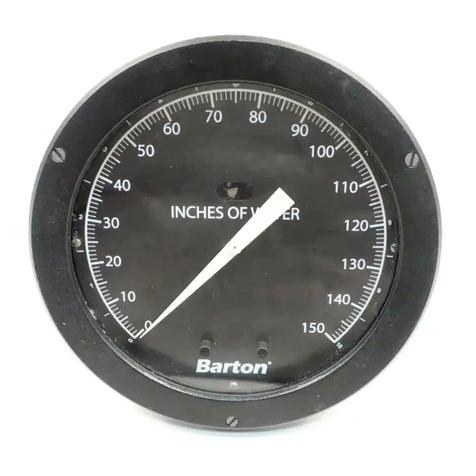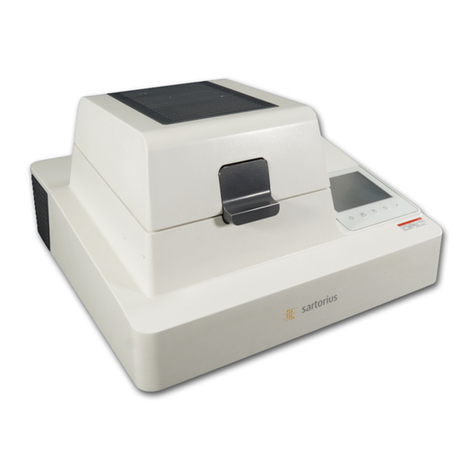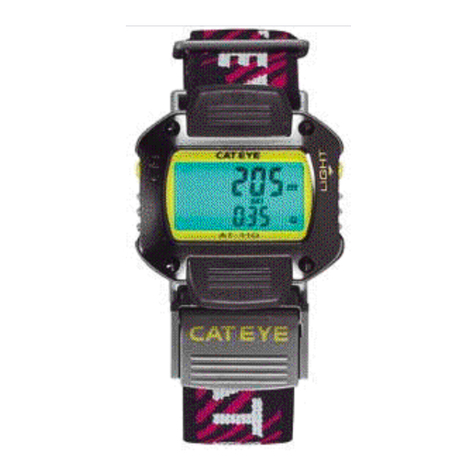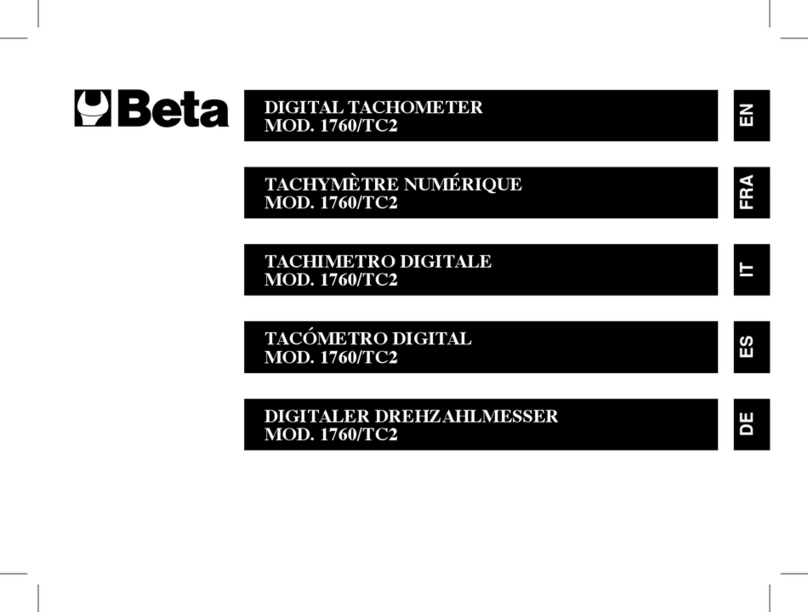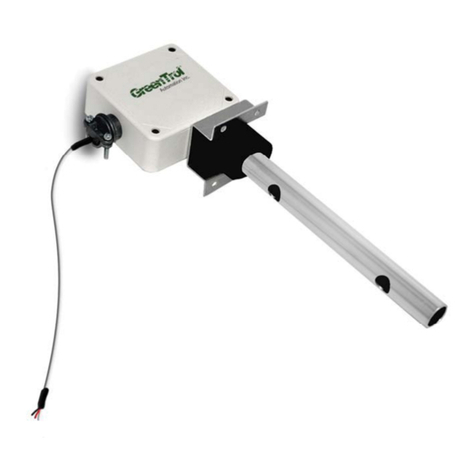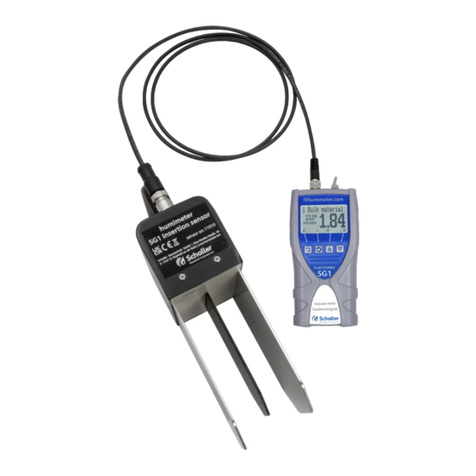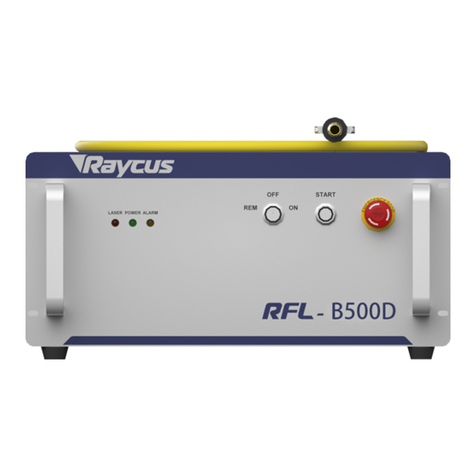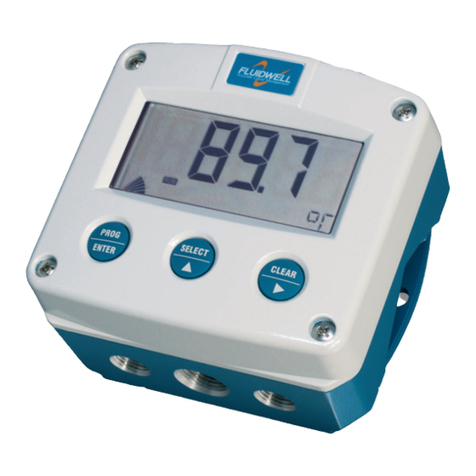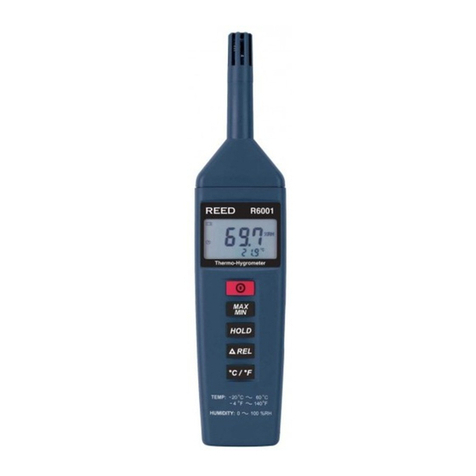Barton 227C User manual

MODEL 227C
DIFFERENTIAL PRESSURE INDICATOR
w/224C DPU
Installation Manual
Version 00K25c
ID#10120
11/2000
SECTION 1 - INTRODUCTION
General
The Model 227C DP Indicator measures liquid flow or liquid level. For flow
measurements, the instrument is connected to the low and high pressure sides
of a primary device (e.g., orifice plate, venturi tube, or flow tube) located in the
process run. For liquid level, the instrument is connected to measure changes in
differential pressure relative to variations of liquid height in a vessel.
Theory of Operation
The bellows within the DPU moves in response to changes in the differential
pressure measured at the primary device installed in the process system.
Movement of the bellows (in direction of decreasing pressure) is mechanically
transferred to the indicator mechanism, which in turn positions the indicating
pointer.
SAFETY
Before installing this instrument, become familiar with the installation instructions
in Section 2. WARNING notes that appear on the following pages of this manual
should be reviewed before proceeding: 3, 6, and 7.
WARNING notes indicate the presence of a hazard which can cause severe
personal injury, death, or substantial property damage if warning is ignored.
CONTENTS
Section 1 - Introduction ............................................................. Page 1
Section 2 - Installation ............................................................... Page 2
Section 3 - Maintenance ............................................................ Page 4
Section 4 - Troubleshooting ....................................................... Page 9
Section 5 - Installation Drawings................................................. Page 10
Section 6 - Parts/Drawing List ................................................... Page 14
DPU Specifications ................................................................... Page 19
Instrument Specifications ........................................................... Back Page

2
SECTION 2 - INSTALLATION
General
The instrument should be inspected at time of unpacking to detect any damage
that may have occurred during shipment. Note: The DPU was checked for
accuracy at the factory — do not change any of the settings during examina-
tion or accuracy will be affected.
For applications requiring special cleaning/precautions, a polyethylene
bag is used to protect the instrument from contamination. This bag
should be removed only under conditions of extreme cleanliness.
DPU Installation
Mounting
A. Flush or Panel
1. Cut an opening in the panel and drill four holes (17/64"), per outline
dimension drawings (Section 5).
2. Pass the instrument through the cutout in the panel (from panel front).
3. Attach the indicator to the panel with four screws.
B. Wall
1. Remove the pipe mounting U-bolts from bracket.
2. Drill four holes in the wall to match the bracket mount holes, per
outline dimension drawing.
3. Attach indicator to wall with bolts and nuts.
C. Pipe
Refer to outline dimension drawing. The unit must be mounted approxi-
mately level for proper operation.
Piping
Observe the following practices:
1. Shorten the distance between the primary device and the DPU as much as
possible. Distances exceeding 100 feet are not recommended. For
distances up to 50 feet, use 1/4-inch pipe or tubing. For runs of 50 to
100 feet, use 1/2-inch pipe or tubing. The recommended limitation does
not apply if an air purge or blow-back system is used.
2. Slope all piping at least one inch per linear foot to avoid liquid or gas
entrapment.
3. Provide two feet of uninsulated piping between the DPU and the primary
device for each 100 degrees in excess of +180°F (+162°C), if process
media exceeding +200°F (+93.3°C) must be measured.
4 Assure that the temperature of the DPU never exceeds 180°F (+162°C).
When steam tracing is necessary, the steam pressure should not exceed five
pounds per square inch and insulation should not be used. If pressure must
exceed five pounds per square inch, limit the length of tubing around the
DPU to two turns and do not insulate.
5. When severe pulsation is present, install a suitable pulsation dampening
device upstream of the DPU; otherwise, accuracy will be affected.

3
6. Mount the DPU on a solid support to minimize vibration. Tighten all
points, using a suitable compound; leaks in piping can cause measurement
errors.
7. Rotate the housing as necessary to place the connection in the proper
position. The DPU has connections in the pressure housings to accommo-
date various pipe sizes (refer to Section 5 Outline Dimensional Drawing).
8. Install a valve manifold connecting the DPU and the source of differential
pressure to facilitate operation and checking of the DPU.
9. Install all shutoff and bypass valves so they are easily accessible from the
front of instrument. Locate block valves at the source of differential
pressure.
WARNING
HIGH PRESSURE HAZARD. TO PREVENT PERSONAL INJURY
OR DAMAGE TO EQUIPMENT, DIRECT ALL PIPING AWAY FROM
THE OPERATOR WHILE CONNECTING THE DPU TO THE
SYSTEM PIPING.
NOTICE
Do not share filling or vapor return lines with DPU piping lines.
Startup
Observe the following practices when starting up an instrument:
1. Always start with the block valves closed.
2. Perform a zero check on the instrument as follows.
a. Open the bypass valve(s), then open one shutoff valve. This procedure
equalizes the pressure between both sides of the instrument. The
instrument should indicate zero.
b. If the instrument does not indicate zero, check for gas or liquid
entrapment in the lines or in the DPU (depending on the orientation of
the piping layout and service).
c. If necessary, adjust the pen or pointer by turning the zero adjust on the
instrument.
NOTE: For gas service, it is recommended that zero check be performed
with both block valves closed. If the gas flow is pulsating, there may be a
standing wave effect in the process line which can displace the indicator
and appear as a zero error.
3. Check the manifold and piping for leaks as follows.
a. Open the bypass valve(s), then open one shutoff valve to pressurize the
instrument.
b. Close the shutoff valve and the bypass valve.
c. Any leakage will be indicated by pen or pointer movement, up or down
scale.
NOTE: Be careful not to subject the DPU to unnecessary shock or
overrange pressure during operations.

4
Required Tools
Tool Purpose
Pointer puller Pointer removal
Small screwdriver Calibration adjustments
Medium screwdriver Bezel removal/DPU bracket screws
1/8" Open-end wrench Calibration adjustments
50 lb. Torque wrench Pressure housing bolts
3/16" Allen socket wrench Pressure housing bolts
5/16" Allen socket wrench Pressure housing bolts
Calibration Kit
Torque Wrench (50 ft./lbs.) Pressure housing bolts
Test/Calibration Equipment
Accessing Indicator Mechanism
Before attempting to perform
calibration of the instrument,
remove the cover glass, scale plate
and pointer of the indicato}`as
follows:
1. Loosen three bezel screws
located on the front of the
bezel.
2. Tilt out the bottom of the
bezel and slide the bezel
upward.
3. Remove the indicating pointer
using the pointer puller.
4. Remove the scale mounting screws and remove the scale plate.
Disassembly to this point provides full access to all indicator movement parts
and adjustments.
SECTION 3 - MAINTENANCE

5
Calibration Check
Normally all that is required to adjust the indicator to the factory-set calibration
tolerances is to perform the following calibration check.
1. Connect the instrument to a standard pressure source as shown in Test/
Calibration Equipment, page 4.
2. Remove the plug from the low pressure housing.
3. Apply approximately 150% of the differential pressure range to the high
pressure housings. Release pressure. Repeat 3 or 4 times.
4. Apply 0%, 50% and 100% of full scale pressure. If indication is within the
specified limits, no further adjustments are necessary. If the zero indication
is incorrect, remove the bezel and glass assembly (per Accessing Indicator
Mechanism procedure on page 4) and adjust the pointer by turning the
pointer by the hub.
5. Replace the bezel and glass assembly. The bezel gasket
(0277.0026C) must be installed as shown below:
The two snubbers (0266.0028C) on the scaleplate should not be com-
pressed against the glass cover and the pointer should not touch the glass.
Notice
Ensure correct bezel gasket orientation before placing instrument
back in service. Incorrect bezel gasket orientation will cause the
instrument indicator to jam, resulting in inaccurate readings.
Complete Calibration
A complete calibration of the instrument is required whenever the DPU assem-
bly is replaced.
1. Connect the instrument to a standard pressure source as shown in the Test/
Calibration Equipment illustration on page 4.
2. Attach linkage between drive arm and movement. (The illustration on the
right shows alignment at 50% differential pressure.)
Inspect parts for straightness and pivot-fit without binding.
3. Set the pointer at zero on the scale by slipping the pointer on the hub.
Hold the pointer tip and turn the hub with a wrench.
4. Apply 100% differential pressure. If pointer exceeds 100% on the scale,
lengthen the range arm. Remove pressure.

6
Cleaning and Inspection
WARNING
(High Pressure Gas Installations
with pressures greater than 200 psig)
HIGH PRESSURE GAS HAZARD ON DISASSEMBLY OF DPU. TO
PREVENT POSSIBLE SEVERE PERSONAL INJURY, DEATH, OR
SUBSTANTIAL PROPERTY DAMAGE DUE TO THE RELEASE OF
INTERNAL PRESSURE, PERFORM THE PRESSURE CHECK
PROCEDURE THAT FOLLOWS (Step A) BEFORE REMOVING
THE DPU HOUSING BOLTS.
NOTICE
If accumulation of solids or semi-solids is extensive, remove the housings
carefully to prevent damage to the bellows.
A. Pressure Check
This procedure should be performed prior to removing the DPU housing
bolts, especially if the DPU has been installed in gas applications with
working pressures greater than 200 psig.
1. Back off all housing bolts 4 turns.
5. Set zero and span using the hub for the zero adjustment and the range
adjust screw on the movement for span adjustments.
6. Apply 50% differential pressure. If linearity adjustment is required, loosen
the drive arm and move the arm to shift the pointer in the direction of the
error (approximately 10:1). Re-tighten drive arm.
7. Reset zero and check
span. If the gear in the
movement reaches its
limit of travel due to the
linearity adjustment, slop
the gear approximately
5°from the 37.5°angle
to approximately 43°.
Retest at 50% and 100%
differential pressure and
adjust linkage until
pointer readings are
acceptable.
8. Apply 0%, 25%, 50%, 75%, and 100%, 75%, 50%, 25%, and 0%
differential pressure to the indicator without overshoot. Lightly tap the
indicator to overcome the effects of friction.
9. Test repeatability at 0%, 50%, 0% 50%.
10. Set stops to prevent pointer from striking snubbers on the scale.
11. Tighten all screws. Test by moving the pointer (by finger) from zero to 50%
and return. An off-set in zero reading indicates pointer slippage.

7
2. Check for internal pressure by attempting to move the housing in and
out along the bolts.
a. If the housing moves freely — no pressure is present — servicing
or repair may continue.
b. If the housing does not move freely — the bellows may be
pressurized and is potentially hazardous if further disassembled.
Tighten the bolts and return the unit to the factory or authorized
Barton service center for repair.
Tag the unit and specify “Gas in Bellows”.
B. Cleaning/Inspection Procedure
Instruments used in services where solids or semi-solids may accumulate
inside the pressure housings require periodic inspection and cleaning, as
follows.
1. Remove the DPU from service and remove the pressure housings.
2. Carefully remove the pressure housings from the bellows unit assembly.
NOTICE
IF THE ACCUMULATION OF MATERIAL INSIDE THE HOUSING IS
EXTENSIVE, RAPID REMOVAL OF THE HOUSING MAY DAMAGE
THE BELLOWS CONVOLUTIONS.
3. Remove the accumulation from between the bellows convolutions and
from the inside of the housings. Use a solvent if possible. Do not use
a sharp instrument to clean between convolutions.
4. Assure that there are no broken range springs.
5. Replace the housings and O-rings.
6. Set the pressure housing bolts to the torque values listed on page 8.
Range Change
To change the range of the DPU, the bellows unit assembly (BUA) must be
replaced with a unit of the desired range. See BUA Replacement Procedure.
BUA Replacement
WARNING
Review the Warning and Notice under Cleaning and Inspection on page 6
before performing this procedure.
NOTICE
Do not loosen the drive arm hold plug located in the top of the BUA center
plate, when removing the mounting bracket. If the plug is loosened, the fill fluid
in the bellows will be lost.
1. Remove the instrument from service.
2. Remove the bezel, cover glass, pointer, scale plate of the indicator, per
Accessing Indicator Mechanism on page 4.

8
gnisuoHstloBgnisuoH
*ebuL euqroT
**tF/bL
noitatoR
***seergeD
PWSlairetaMlairetaMeziS
005
000,1 ssarB
leetS
"2x82-4/1
oN
01-8
531
lenoMseY081
000,1 reppoC
syollA
leetS
"5.2x82-4/1
oN
11-9081
lenoMseY
005
005,1 SERC
leetS
"5.2x82-4/1
oN
41-21081
SERCseY
005,1leetS
leetSoN
lenoMseY
000,3
leetSleetS"5.2x42-8/3oN03
09
SERCSERC
"5.2x42-8/3
seY53
"0.3x42-8/3
000,6
leetSleetS
"5.2x42-8/3
oN53
531
SERCSERCseY04
000,01
leetSleetS
"5.2x42-8/3seY
04
081
SERCSERC54
* Lubricants: Molykote G paste, Teflon-base pipe dope, graphite-base grease, or
similar lubricants. Lube first thread only.
** Torque on bolts is accomplished in 3 or 4 steps. Tighten uniformly.
*** Rotation of bolt head is measured after bolt is snug, with approximately
2 ft./lbs.torque. Do not exceed this rotation. To tighten bolts without a torque
wrench, use the following values: 1/4 turn = 90°1/2 turn = 180°
3. Loosen instrument drive arm and separate it from the torque tube shaft.
Do not disconnect the instrument linkage.
4. Remove the indicator movement mounting screws.
5. Remove the four Allen head DPU mounting screws, and separate the DPU
from the indicator case.
6. Perform Pressure Check Procedure under Cleaning and Inspection on
page 6. If internal pressure was found, do not continue. Tighten the
bolts and return the unit to the factory or authorized Barton service
center for repair. Tag the unit and specify “Gas in Bellows”.
7. If no internal pressure was found in Step 6, remove the DPU mounting
bracket, pressure housing bolts, and the pressure housings.
8. Place the pressure housings onto the new BUA and attach with the
housings bolts (see Table below).
Torque Settings
Notice
It is recommended that new O-Rings be used when replacing the
pressure housings.
9. Reattach the DPU to the instrument and install the instrument into service
in reverse order of removal.
10. Perform a full calibration, per Complete Calibration on page 5.

9
melborP elbissoP
secruoS esuaCelbaborPnoitcAevitcerroC
oNrowoL
noitacidnI
yramirP
rotnemelE
UPD
dezisrevOrosdrawkcaBdellatsnIecifirOecifirOecalpeR
nuRmorfmaertspUdekcolBwolF evlaVnepOronuRtuOnaelC
)leveLdiuqiL(geLecnerefeRnidiuqiLfossoLgeLecnerefeRllifeR
roaideMssecorPnisegnahCytisneD
geLecnerefeR
emaShtiwgeLecnerefeRllifeR
aideMssecorPsadiuqiLytisneD
morfgnipiP
yramirP
ottnemelE
UPD
gnipiPro/dnadeggulpselohpaterusserP
deggulP gnipiPtuOnaelC
gnikaeLronepOevlaVssapyB riapeRro)s(evlaVssapyBesolC
skaeL
gnipiPnidepparTsesaGrosdiuqiLgnipiPtneV
desolCsevlaVffo-fuhSrokcolB sevlaVffo-tuhSrokcolBnepO
ediSerusserPhgiHnoskaeLgnipiPskaeLriapeR
swolleB
tinU
gnitcirtseRsdiloShtiwpUdelliFsgnisuoH
tnemevoMswolleB gnisuoHtuOnaelC
roecivreSdiuqiLnignisuoHnidepparTsaG
ecivreSsaGnignisuoHnidepparTdiuqiL gnisuoHtneV
skaeLteksaGgnisuoHerusserPhgiHteksaGecalpeR
htiWderepmaTUPDriapeRrofAUBnruteR
rotacidnI
msinahceM
tnemevoMesooLecalpeRronethgiT
noitarbilaCfotuOetarbilaC
esooLretnioPretnioPnethgiT
msinahceMytriDmsinahceMnaelC
hgiH
noitacidnI
yramirP
ecruoS llamSootrodetcirtseRyllaitraPecifirOecalpeRrotuOnaelC
morfgnipiP
yramirP
ottnemelE
UPD
gnipiPediSerusserPwoLnikaeLriapeR
swolleB
tinU
nignisuoHerusserPwoLnidepparTsaG
nignisuoHnidepparTdiuqiLroecivreSdiuqiL
ecivreSsaG
gnisuoHtneV
skaeLteksaGgnisuoHerusserPwoLteksaGecalpeR
htiWderepmaTUPDronekorBgnirpSegnaRriapeRrofAUBnruteR
rotacidnI msinahceMrosmrAesooLecalpeRroriapeR
noitarbilaCfotuOetarbilaC
citarrE
noitacidnI
yramirP
tnemelE gnitasluPwolF maertspUeciveDgninepmaDllatsnI
nuRUPDfo
morfgnipiP
yramirP
ottnemelE
UPD
elbbuBsaGrognipiPsaGnidepparTdiuqiL
gnipiPdiuqiLni evomeR
dellatsnIyltcerrocnIrotareneGropaVepipeR
gniziropaVdiuqiLroyssaGgeLecnerefeRsnoitcurtsnIgnipiPeeS
swolleB
tinU
levarTswolleBdetcurtsbOswolleBnaelC
woLroerusserPhgiHUPDnidepparTsaG
gnisuoHerusserP )erudecorPputratSeeS(evomeR
rotacidnI
msinahceM
ytriDrogniggarDegakniLnaelCrotsujdA
etalpelacSnogniggarDretnioPnoitisoPretnioPtsujdA
SECTION 4 - TROUBLESHOOTING

10
SECTION 5 - INSTALL DRAWINGS

11

12

13

14
227C Parts Drawing
SECTION 6 - PARTS DRAWING/LIST

15
227C Parts List

16
224C DPU Parts Drawing

17
224C DPU Parts List

18
NOTE: As normally furnished, units having beryllium-copper bellows are
fitted with Buna-N O-rings and units having stainless steel bellows, with
Viton O-rings. In all cases, however, the O-ring compound must be selected
for compatibility with the metered material. Consult factory for other
compounds.

19
LEDOM
C422 YDOB SEGNARERUSSERPLAITNEREFFIDELBALIAVA SNOITCENNOCERUSSERP
isp-PWS
)rab( lairetaMgnisuoH
lenocnIroleetSsselniatS
swolleB swolleBreppoCmuillyreBswolleBlenocnI poTmottoB
.D.O)mm14("8/5-1.D.O)mm14("8/5-1.D.O)mm91("4/3.D.O)mm91("4/3.D.O)mm61("8/5
005
)43(
ssarBdegroF
)2#421B-MTSA(
ot)rabm57-0(.c.w"03-0
)rab1.4-0(isp06-0
ot)rab2.4-0(isp16-0
)rab6.72-0(isp004-0
ot)rab6.72-0(isp004-0
)rab43-0(isp005-0 TPN"4/1TPN"4/1
005
)43( )613(leetSsselniatS ot)rabm57-0(.c.w"03-0
)rab1.4-0(isp06-0
ot)rab2.4-0(isp16-0
)rab6.72-0(isp004-0
ot)rab6.72-0(isp004-0
)rab43-0(isp005-0 TPN"4/1TPN"4/1
000,1
)96(
ssarBdegroF
)2#421B-MTSA(
)rabm941-0(.c.w"06-0
)rab1.4-0(isp06-0ot
ot)rab2.4-0(isp16-0
)rab6.72-0(isp004-0
ot)rab6.72-0(isp004-0
)rab96-0(isp0001-0
TPN"8/1
TPN"4/1
TPN"8/1
TPN"4/1
)03-07(lekciNreppoC
)62751-C-LIM(
)rabm941-0(.c.w"06-0
)rab1.4-0(isp06-0ot ot)rab2.4-0(isp16-0
)rab6.72-0(isp004-0
ot)rab6.72-0(isp004-0
)rab96-0(isp0001-0
4-24161-SM4-24161-SM
005,1
)301(
)8101C(leetSdelloRdloC
)613(leetSsselniatS
ot)rabm941-0(.c.w"06-0
)rab1.4-0(isp06-0 ot)rab2.4-0(isp16-0
)rab6.72-0(isp004-0
TPN"4/1TPN"4/1
000,3
)702(
)8101C(leetSdelloRdloC
)613(leetSsselniatS TPN"2/1TPN"4/1
000,6
)414(
)8101C(leetSdelloRdloC
)613(leetSsselniatS TPN"2/1TPN"4/1
000,01
)986( )0414(leetSyollA )rabm842-0(.c.w"001-0
)rab1.4-0(isp06-0ot
)rabm842-0(.c.w"001-0
)rab1.4-0(isp06-0ot
TPN"4/1
OCNIMA61/9
)TDO"4/1(
TPN"4/1
OCNIMA61/9
)TDO"4/1(
teN
emuloV
.ni.uc
)mc.uc(
daeH.P.L)cc2.72("66.1)cc2.72("66.1)cc1.14("15.2)cc1.14("15.2)cc8.24("16.2
daeH.P.H)cc4.52("55.1)cc4.52("55.1)cc7.93("24.2)cc7.93("24.2)cc9.04("05.2
sehcni.ucnitnemecalpsiD
levartelacs-llufrof )cc3.2("41.0)cc3.2("41.0)cc94.0("30.0)cc94.0("30.0)cc14.0("520.
SNOITACIFICEPSECNAMROFREP
)P.Delacslluf(snoitatoRebuTeuqroT %01±°8
lairetaMebuTeuqroT )uCeB(reppoCmuillyreB
stimiLerutarepmeT )C°28+(F°081+otC°/F°04-
ytiraeniL-noNmumixaM egnarybdeificepS
ytilibataepeR .P.Delacslluffo%2.0
:SETON etulosbA.])rabm211-0-73(.c.w"54-0-51ro)rabm57-0-57(.c.w"03-0-03deredroebyamegnar)rabm941-0(.c.w"06-0a,.g.e[redrolaicepsnoelbaliavasegnartilpsroretnecoreZ
noisnemideniltuO.tseuqernopuelbaliava).cte,.D.N.A,SM,sbutsgnidlew(snoitcennocfosepytdnasezisrehtO.)rab4.14(.isp006ot)rabm57(.c.w"03morfelbaliavasegnarerusserp
.tseuqernopuelbaliavaslairetamtnailpmoc)57-10-RM(ECANhtiwC422M.etamixorppaera)(snoisrevnoccirteM.tseuqernopuelbaliavasgniward
224C DPU Specifications

Barton Instrument Systems, LLC
900 S. Turnbull Canyon Rd.
City of Industry, CA 91745 USA
(626) 961-2547
On the Web at www.barton-instruments.com
©Copyright 2000, Barton Instrument Systems, LLC. All rights reserved.
Instrument Specifications
Actuating Unit ........................ Model 224C DPU
Dial/Scale Size ....................... 6-inches (150 mm)/13-1/2 inches (340 mm)
Adustments ............................ Zero and Span (micrometer-type)
Mounting ............................... Pipe Yoke, Panel, or Wall
Accuracy ................................ 0-30" w.c. to 200 psi DP ±1/2% of full scale
0-200 psi to 0-400 psi DP ±3/4% of full scale
Temperature Limits ................. -40°F/°C to +180°F (+80°C)
Product Warranty
A. Warranty
Barton Instrument Systems, L.L.C. warrants that at the time of shipment the products
manufactured by Barton Instrument Systems, L.L.C. and sold hereunder will be free from defects
In material and workmanship, and will conform to the specifications furnished by or approved by
Barton Instrument Systems, L.L.C..
B. Warranty Adjustment
(1) If any defect within this warranty appears, Buyer shall notify Barton Instrument Systems,
L.L.C. immediately.
(2) Barton Instrument Systems, L.L.C. agrees to repair or furnish a replacement for, but not
install, any product which within one (1) year from the date of shipment by Barton
Instrument Systems, L.L.C. shall, upon test and examination by Barton Instrument
Systems, L.L.C., prove defective within the above warranty.
(3) No product will be accepted for return or replacement without the written authorization of
Barton Instrument Systems, L.L.C.. Upon such authorization, and in accordance with
instructions by Barton Instrument Systems, L.L.C., the product will be returned shipping
charges prepaid by Buyer. Replacements made under this warranty will be shipped prepaid.
C. Exclusions from Warranty
(1) THE FOREGOING WARRANTY IS IN LIEU OF AND EXCLUDES ALL OTHER EXPRESSED
OR IMPLIED WARRANTIES OF MERCHANTABILITY, OR FITNESS FOR A PARTICULAR
PURPOSE, OR OTHERWISE.
(2) Components manufactured by any supplier other than Barton Instrument Systems, L.L.C. shall
bear only the warranty made by the manufacturer of that product, and Barton Instrument
Systems, L.L.C. assumes no responsibility for the performance or reliability of the unit as a
whole.
(3) "In no event shall Barton Instrument Systems, L.L.C. be liable for indirect, incidental, or
consequential damages nor shall the liability of Barton Instrument Systems, L.L.C. arising in
connection with any products sold hereunder (whether such liability arises from a claim based on
contract, warranty, tort, or otherwise) exceed the actual amount paid by Buyer to Barton
Instrument Systems, L.L.C. for the products delivered hereunder."
(4) The warranty does not extend to any product manufactured by Barton Instrument Systems,
L.L.C. which has been subjected to misuse, neglect, accident, improper installation or to use in
violation of instructions furnished by Barton Instrument Systems, L.L.C..
(5) The warranty does not extend to or apply to any unit which has been repaired or altered at any
place other than at Barton Instrument Systems, L.L.C.'s factory or service locations by persons
not expressly approved by Barton Instrument Systems, L.L.C..
Table of contents
Other Barton Measuring Instrument manuals
Popular Measuring Instrument manuals by other brands
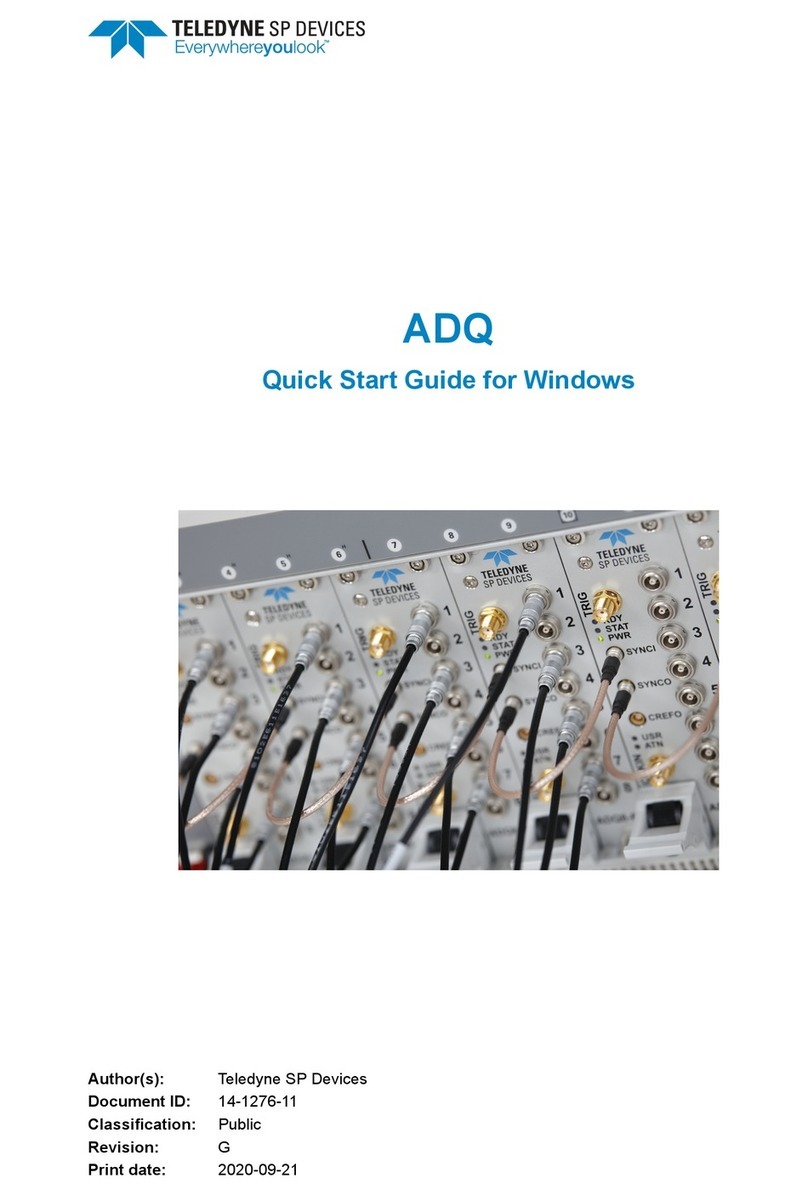
Teledyne SP Devices
Teledyne SP Devices ADQ quick start guide
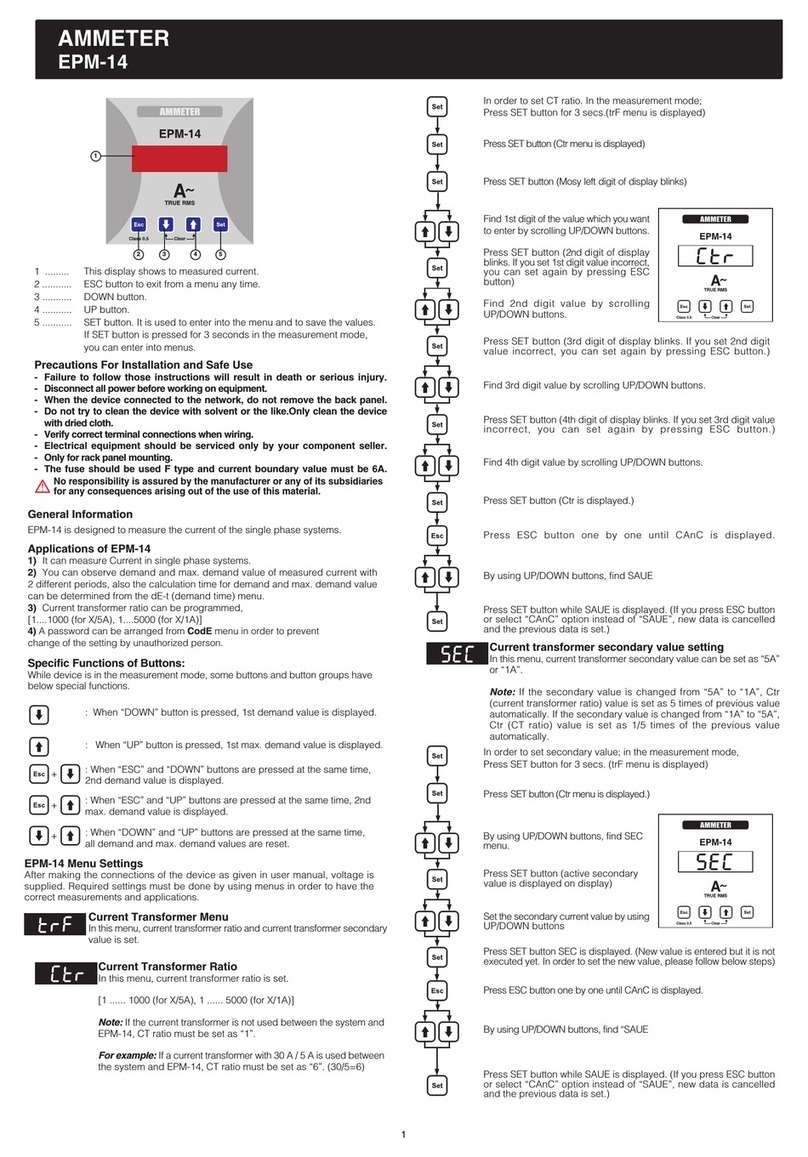
Ammeter
Ammeter EPM-14 manual

Endress+Hauser
Endress+Hauser prowirl 77 operating manual
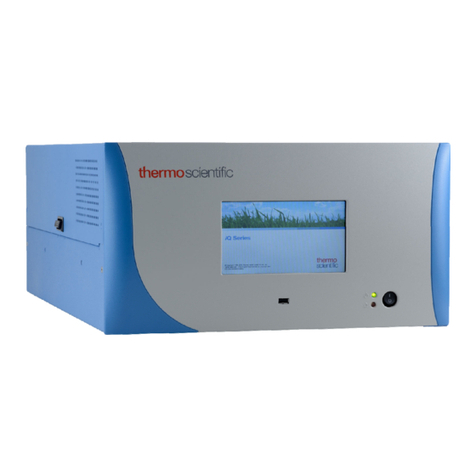
ThermoFisher Scientific
ThermoFisher Scientific Ozone Primary Standard 49iQPS instruction manual
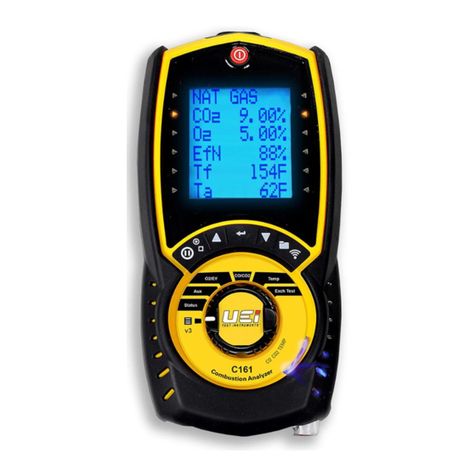
UEi
UEi C161 instruction manual
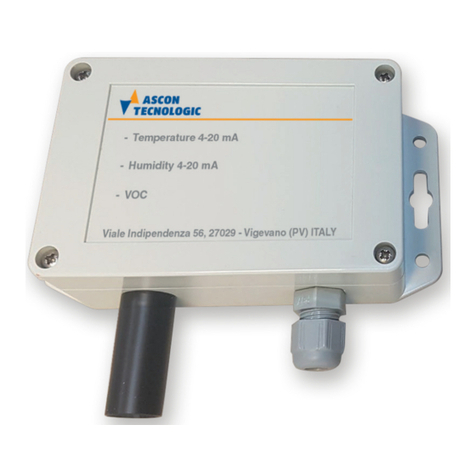
Ascon tecnologic
Ascon tecnologic TRH514 user manual
